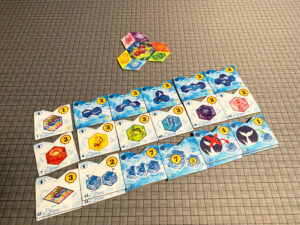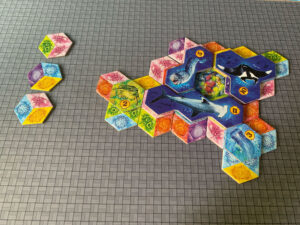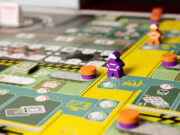 In addition to a lot of games being themed on nature, there’s also been a bit of an 80s and 90s renaissance so when I first heard about Aqua I wasn’t sure if this was about life around a coral reef or the Danish electronic dance band of the same name, but I was intrigued either way.
In addition to a lot of games being themed on nature, there’s also been a bit of an 80s and 90s renaissance so when I first heard about Aqua I wasn’t sure if this was about life around a coral reef or the Danish electronic dance band of the same name, but I was intrigued either way.
Aqua is a game for 1–4 players aged eight and up and plays in about 30–45 minutes. It was designed by Dan and Tristan Halstad (coincidentally also from Copenhagen) and illustrated by Vincent Dutrait.
So come on Barbie, let’s go party.
Gameplay Overview:
Good morning, Sunshine! Aqua is played over 17 rounds and the goal is to grow coral reefs attracting small and large animals. At the start of the game, you’ll select 6 ecosystem tiles (objectives) that you’ll randomly assign to one of each of the small animal tiles.
The game is played with a set number of tiles for each player count which is stated on the back of each of the four unique hot spot tiles which also double as each player’s starting spot.

Each round, the player with the snail first player marker draws a number of tiles equal to the number of players plus one. The first player puts the snail near these tiles and then chooses the tile of their choice or the snail. Any player that picks the snail will now pick last in the round but first in the next round and the last player automatically gains the sea snail if it’s unclaimed. The last, unchosen tile, stays in the pool and another set of tiles is drawn for the next round (except in solo mode where unselected tiles get removed).
A selected tile then gets placed in their reef. To properly place a tile one of the sides needs to match a side of the existing reef. If there’s a hexagon shape within that color of coral, you can add a small animal matching that color. If you have different small animals arranged in the shape of one of the large animals, you can then place one of those tiles. These animal actions do not have to be completed the turn the requirements are met allowing players to decide if they want to keep growing their reef to score better/larger animals. But a large animal must cover a small animal that is placed that turn.
The game continues until the coral is gone and then end game points are tallied. Highest score wins with the losers probably wishing they could turn back time.
Included in the rule book is a variant for family scoring (ignore reefs and ecosystems) as well 15 scenarios with various objectives, 25 challenges, and 10 modifications to mix in to the game to make happy boys and girls as well as a solo mode.

Game Experience:
Starting with the obvious, the art is gorgeous and I love how the large animal tiles have different animals on each side giving the player a choice of choosing between team dolphin and team Dugong (a relative of the manatee).
The components are thick cardboard tiles and, as an environmentally friendly production choice, used minimal plastic in the packaging with the game including a cardboard insert you can assemble and paper wrapping the punchboards.

The core concept is so basic—draft and place a tile to place small animals. I didn’t think you could even effectively hate draft because there are always different areas you could work on (kid tested, adult approved) although shrewd players will be able to block moves if they’re paying attention to other players’ areas. And if you see there’s nothing calling you, I like how you can just go last to take first pick next turn although that never came up in my plays with my family.
One thing that I was unsure of is whether a reef could also be a habitat. I kind of assumed yes and the reef scoring doesn’t give you points for any animals in that reef (as you already scored them for the habitat).
Something I enjoyed is, like a lot of tile laying games, the feeling you’re building towards something and Aqua is no exception because at the end you have a colorful reef with animals that you can admire. The fairly limited decision space is a good thing for this gateway-ish game because each tile can fit one of three ways and you only have to match one side. This allows people to look at their reef and build towards the large animal tile they want and, if there’s nothing available, pivot to do something else and wait to see if there’s a better selection next turn. And remember that tile that nobody has wanted for three turns? At some point, it’s going to be taunting you “come n’ get it (I know that you want to)” because you all of a sudden need that piece.

Calling Dr. Jones, wake up now: we’re scoring now. This is probably the most difficult part of the game and something to be aware of if getting it for non-gamers. I would teach this to non-gamers easily using the family variant, which only scores the small and large animal tiles, and I think most folks will grasp this game within the first few turns of their first game. But I would only introduce the more involved scoring system later.
The full scoring system takes a while to score and is my least favorite part of the game due to the time it takes to go through each layer of scoring. For example, you’ll score large and small animals and then have to go through six ecosystems that range from “score 1 point for each small animal adjacent to this specific type” to “For every native small animal (for that ecosystem) score 2 points per small animal adjacent to it, this is native to the ecosystems immediately to the left and right of this ecosystem.” I’m sure it speeds up as you get familiar with it but once you start adding in the variable scoring tiles I have a hard time imagining that this is going to be second nature for me. Overall, while I get and appreciate the added depth of the scoring, I think it’s a mismatch for the target complexity of the game.
Final Thoughts
My Oh My Aqua is a banger (you could add “by” before “Aqua” and it’s still true) and could be a good fit in many people’s collections. I really like Aqua as a game that’s both easy to teach and play but also offers some choices for gamers who want a bit more meat. My one complaint is really the mismatch in scoring complexity for such a simple game. However, this is the exact thing that also makes it more compelling solo, or with more experienced gamers, with all of the different challenges.
Final Score: 4 Stars – Aqua Biodiversity in the Oceans is a simple and colorful game that has both physical and mental layers that make it a great fit for gateway to experienced gamers.
 Hits:
Hits:
• Simple to teach
• Plenty of strategic choices to make allowing for both short- and long-term planning
• Beautiful art
• Lots of variability with various scoring options and challenges
Misses:
• The scoring, without the family variant, is fairly complex for a gateway game
• The iconography on the scoring tiles wasn’t intuitive





















